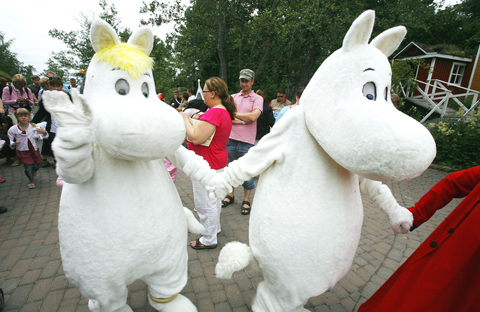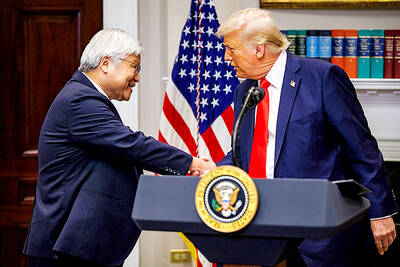In one of the quirkiest book cults the US has never heard of, a round-snouted troll is hauling consumers’ wallets from their pockets despite the worst recession in decades.
The license-holders for Moomin, who say license sales increased 35 percent this year, are contemplating expansion.
“We want to grow and be as profitable as we have been so far, but in a way that increases the awareness of Moomin, starting from countries where books already are sold,” Sophia Jansson said.

PHOTO: REUTERS
The artistic head and chairman of Moomin Characters, she is the niece of Finnish author and illustrator Tove Jansson, whose creation, the Moomintrolls, soon turn 65.
Moomins — whose naive hero Moomintroll was the “nastiest creature” teenage Tove Jansson could imagine after a quarrel with her brother — are a lucrative publishing and licensing niche mostly in Nordic countries, Japan and Britain.
Since the 1945 publication of The Moomins and the Great Flood, adventures with Moomin and parents Moominmamma and Moominpappa have featured in 13 novels and picture books translated into 40 languages, and thousands of cartoon strips.
The characters have also been used to brand a wide range of products, including kitchenware, diapers, DVDs and tinned candy.
“They made me feel peaceful,” said Tokyo-based Hideyuki Masumoto, 40, describing the characters he called his childhood friends, while eyeing gifts in the tiny Moomin shop in Helsinki. “They remind us of how we used to live in Japan — in a small community where everyone knows each other.”
In Japan, children in the 1960s grew up with an animated television series of the trolls and loved Moomin, Masumoto said. His personal hero was Moomin’s friend the wayfarer Snufkin, the “wise guy, who plays music and doesn’t belong anywhere.”
Inhabiting a land called Moominvalley, Moomins play into a similar vein of comfort to Disney’s Winnie-the-Pooh, revived by publishers Egmont in an Oct. 5 sequel, but the deeply Finnish characters tap much darker mysteries than Pooh.
Bjorn Lindergaard, 30, a Dane in Helsinki on UN training, said he liked that the tales were inventive and realistic, and none of the characters were perfect. For example Little My, a tin-sized, fierce girl, with a positively aggressive temper.
“The Moominvalley looked very friendly, but there was also a darker side to it. Life was not just plain idyllic,” he said.
Peaceful and realistic is how people see Moomins, but they are not human, said Sophia Jansson, whose firm manages the Moomintroll legacy and copyrights including up to 300 licensees.
“The Moomins are not people. You can’t send them up the Eiffel Tower, they don’t speak on cellphones, drive cars, or carry guns,” she said.
Moomin Characters chief executive Roleff Krakstrom said he is eyeing the US market. Moomin books were sold there half a century ago, but the firm has no licensees and animations have aired only on Hawaii.
He is cautious, however.
“It is possible, but not obligatory,” Krakstrom said. “We are reluctant to start a big project that could fail and label Moomin for a long time.”
Last year, Moomin Characters, which was founded by Tove Jansson and her brother and co-illustrator Lars Jansson, collected US$6.69 million in license income and sales from its three brand shops in Helsinki, with operating profit at US$2.18 million.
“Some think Moomin is only for the smallest family members, but for instance in Japan, our main target group is 20 to 35-year-old women,” Sophia Jansson said.
Products for adults make up half the firm’s sales.
Technologies such as digital media are helping characters cross borders, said Marty Brochstein, senior vice president of the international Licensing Industry Merchandisers’ Association (LIMA), but she warned that cultural characteristics were important.
In Japan, Moomin plays into a long-running craze for cute things, said Roger Berman, managing director of the Japanese branch of LIMA. It was a similar story to many characters seen in the West as targeting children, such as Peter Rabbit by Beatrix Potter or The Very Hungry Caterpillar by Eric Carle.
“If it looks cute, Japanese adults will buy as much as a child will. They will happily display character hang straps from their mobile phones without self-consciousness,” Brochstein said.
Martin Olausson, digital media director at Strategy Analytics, pointed out, however, that with Disney recently agreeing to buy Marvel’s superheroes, the consolidating industry is tending to focus on established characters to minimize risk, rather than introduce new ones.
“Profitability depends on how strong the brand is,” Olausson said. “There is a very wide spectrum, but firms like Marvel, with a library of globally big characters, can charge a lot.”
In North America, character royalties slid 3.9 percent to US$2.6 billion last year. Giants like Disney and Marvel have suffered as consumers reined in purchases.
The Moomintrolls — curious, bohemian, generous — may be a bit more edgy and eccentric than the US mainstream.
Moomintroll is friendly and wide-eyed. He picks flowers and likes to fish. Besides Little My, who plays pranks, his friends are oddball. Snufkin smokes a pipe.
Where Pooh’s Hundred Acre Wood has Eeyore the grumpy donkey, Moominvalley has a melancholy scientist, the Hemulen. A hill-shaped, lethal spook called the Groke invokes all winter’s pain. Even the comedy Hattifatteners — finger-shaped electric creatures which move in a flock — are unsettling.
Tove Jansson, who died in 2001, said her own experiences were the basis for her work and the experience of war may be one distinguishing factor making Europeans and Japanese susceptible to her sense of shyness and feelings of disaster.
Some experts, like Chris Anderson, author of The Long Tail, have said technology now allows firms to cater to increasingly fragmented audiences, boosting niche products.
Olausson, however, while not ruling out that Moomins could catch on, said there was little evidence to show a niche product could thrive in the profit-driven US market without the backup of a big player.
Lana Castleman, managing editor of Canadian trade magazine KidScreen, was also cautious about the chances of success for Moomins in a market that has traditionally favored princesses and spidermen above new characters.
“It’s a completely different mindset,” Castleman said. “They [Moomins] are very different from current and historical American characters, such as Mickey and Winnie, both in the way they look and content of the stories.”

CRITICAL MOVE: TSMC’s plan to invest another US$100 billion in US chipmaking would boost Taiwan’s competitive edge in the global market, the premier said The government would ensure that the most advanced chipmaking technology stays in Taiwan while assisting Taiwan Semiconductor Manufacturing Co (TSMC, 台積電) in investing overseas, the Presidential Office said yesterday. The statement follows a joint announcement by the world’s largest contract chipmaker and US President Donald Trump on Monday that TSMC would invest an additional US$100 billion over the next four years to expand its semiconductor manufacturing operations in the US, which would include construction of three new chip fabrication plants, two advanced packaging facilities, and a research and development center. The government knew about the deal in advance and would assist, Presidential

‘DANGEROUS GAME’: Legislative Yuan budget cuts have already become a point of discussion for Democrats and Republicans in Washington, Elbridge Colby said Taiwan’s fall to China “would be a disaster for American interests” and Taipei must raise defense spending to deter Beijing, US President Donald Trump’s pick to lead Pentagon policy, Elbridge Colby, said on Tuesday during his US Senate confirmation hearing. The nominee for US undersecretary of defense for policy told the Armed Services Committee that Washington needs to motivate Taiwan to avoid a conflict with China and that he is “profoundly disturbed” about its perceived reluctance to raise defense spending closer to 10 percent of GDP. Colby, a China hawk who also served in the Pentagon in Trump’s first team,

SEPARATE: The MAC rebutted Beijing’s claim that Taiwan is China’s province, asserting that UN Resolution 2758 neither mentions Taiwan nor grants the PRC authority over it The “status quo” of democratic Taiwan and autocratic China not belonging to each other has long been recognized by the international community, the Mainland Affairs Council (MAC) said yesterday in its rebuttal of Beijing’s claim that Taiwan can only be represented in the UN as “Taiwan, Province of China.” Chinese Minister of Foreign Affairs Wang Yi (王毅) yesterday at a news conference of the third session at the 14th National People’s Congress said that Taiwan can only be referred to as “Taiwan, Province of China” at the UN. Taiwan is an inseparable part of Chinese territory, which is not only history but

INVESTMENT WATCH: The US activity would not affect the firm’s investment in Taiwan, where 11 production lines would likely be completed this year, C.C. Wei said Investments by Taiwan Semiconductor Manufacturing Co (TSMC, 台積電) in the US should not be a cause for concern, but rather seen as the moment that the company and Taiwan stepped into the global spotlight, President William Lai (賴清德) told a news conference at the Presidential Office in Taipei yesterday alongside TSMC chairman and chief executive officer C.C. Wei (魏哲家). Wei and US President Donald Trump in Washington on Monday announced plans to invest US$100 billion in the US to build three advanced foundries, two packaging plants, and a research and development center, after Trump threatened to slap tariffs on chips made